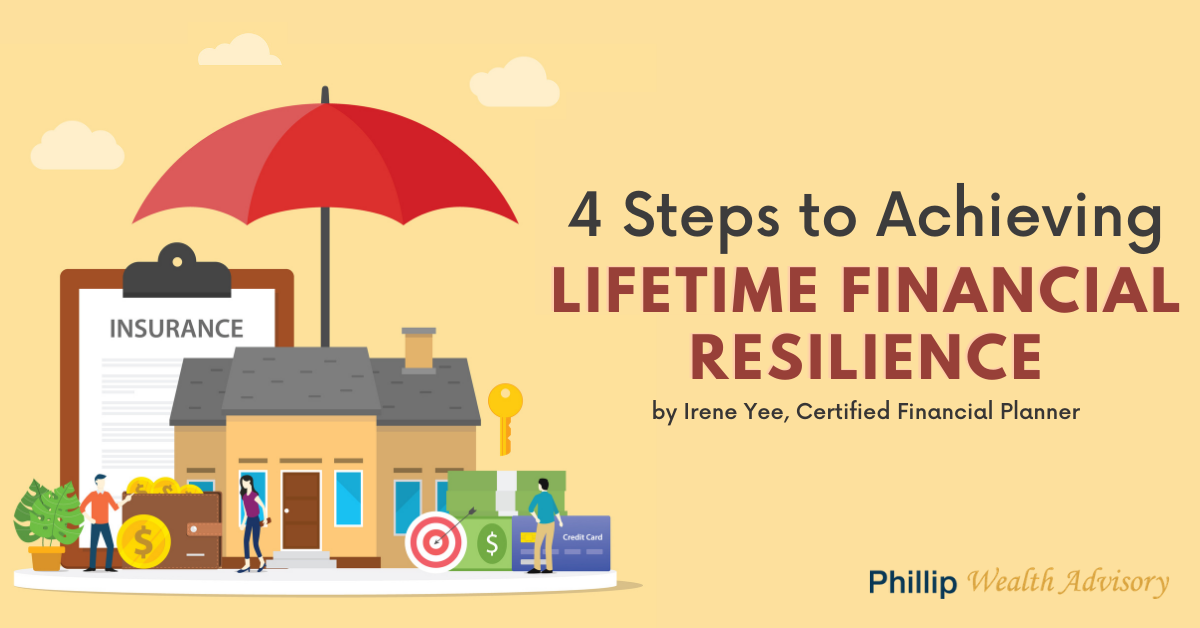4 Steps to Achieving Lifetime Financial Resilience November 11, 2020

In unprecedented times of personal, financial and health uncertainties such as this, it bodes well for each of us to take action in our personal financial planning with these 4 practical steps:
- Enhance your MediShield Life with suitable private Hospitalisation & Surgery Shield plans
- Supplement your ElderShield with private longterm care cover
- Increase your family/ dependent protection cover in addition to your current DPS
- Plan your retirement cashflow with CPF Life as your foundation
With increased uncertainties wrought by an unprecedented global pandemic, it is essential for everyone to boost his or her lifetime financial resilience. Do this by supplementing national protection plans with schemes from established financial institutions.
Which are the top areas of personal finance you need to review?
1) Hospitalisation and surgery expenses
Hospitalisation and surgery expenses should ideally be managed with not only MediShield Life but also private Hospitalisation & Surgery (H&S) Shield plans.
MediShield Life provides lifetime health insurance and is available to all Singapore citizens and permanent residents. This national health insurance scheme covers pre-existing health conditions, with no maximum age for entry.
MediShield Life subsidises treatment in public hospitals and is pegged to B2/C-type wards. Should you choose to stay in an A/B1-type ward in a public or private hospital, the plan will cover only a portion of your hospital bill. You will need to draw from CPF Medisave and/or use cash to foot the rest.
Due to MediShield Life’s sub-limits for each class of surgical procedures, you may not be covered for all surgeries. Which means you will most probably have to pay part of your bills out of pocket. To mitigate your payments using Medisave or cash, you can opt to take up additional cover from private H&S Shield plans. Premiums for such plans can be partially paid with CPF Medisave, ranging from S$300 to S$900 per year, depending on age.
2) Long-term care insurance
Long-term care insurance was implemented with ElderShield in 2002.
This is a basic plan for all Singaporeans with an option to opt out. ElderShield covers severe disabilities or when one is unable to perform three out of six daily activities such as walking, toileting and feeding.
The current plan will give you S$400 a month for six years if severe disability strikes. It should ideally be supplemented with private care plans for longer or even lifetime payouts to cover severe disabilities. Private supplementary plans can be paid with CPF Medisave for up to S$600 a year.
You may ask, “Why are private plans still necessary when there is ElderShield?”
Long-term payout needs are usually related to ageing. Nursing homes or home nursing can cost an arm and a leg in Singapore. The basic cost ranges from S$2,000 to S$3,600 a month to stay in a nursing home (before MOH subsidy), depending on the level of care needed. 1ElderShield only pays you S$400 a month at the moment.
3) Term insurance in the event of death, terminal illness or total permanent disability (TPD)
The government’s Dependants’ Protection Scheme (DPS) is a basic term life plan that provides CPF members and their families with S$46,000 when the CPF members die or suffer from terminal illness or TPD.
The two biggest reasons to enhance or supplement this plan are:
1) DPS only covers until age 60. Singaporeans are increasingly living beyond this; and
2) DPS’ definition of TPD is less generous than term insurance from private providers. For instance, private providers pay out for TPD once the insured cannot perform three out of six daily activities before age 70.
4) Retirement cashflow planning
a) CPF Life
About 50% of Singaporeans now live beyond 85 years.
One in three will live beyond 90.
This is according to the latest statistics from CPF Board.
As more Singaporeans live longer, where are they going to find the money to fund their longer retirement lives?
Assuming that your CPF Full Retirement Sum is met by age 55 in 2020, i.e. S$181,000 has been set aside without a property pledge, CPF Life will provide lifetime monthly income of S$1,390 to S$1,490 under its default Standard Plan. These are monthly estimates for members who turn 65 in 2030 (source: CPF Board).
To increase your retirement cash flows to S$2,000 to S$3,000, you can and should consider supplementing CPF Life with private retirement plans to meet your individual retirement needs.
Why S$2,000 to S$3,000? This is the range generally considered comfortable for the average Singaporean based on current living costs.
b) SRS
The government introduced its Supplementary Retirement Scheme (SRS) in 2001 to help Singaporeans boost their savings for retirement while giving them tax relief in the years that they make SRS contributions.
SRS complements CPF, which is intended to provide for your basic living needs after retirement, in addition to current housing and medical needs.
Participation in SRS, however, is voluntary. SRS members can contribute up to the annual capped amount of S$15,300 for Singapore citizens and permanent residents as of FY2020. Contributions may be used to purchase investment instruments such as private retirement cash flow plans to bolster retirement savings.
Investment returns are accumulated tax-free. Only 50% of any withdrawal is taxable at the retirement age, i.e. there is a 50% tax concession.
Withdrawals before the statutory retirement age is subject to 100% tax, plus a 5% penalty.
The 50% tax concession only applies to withdrawals from the current statutory retirement age of 62, over a 10-year withdrawal window.
Now is a good time to review your personal finance. COVID-19 has caused massive disruptions and uncertainties over jobs, investment portfolio performances and retirement targets.
Find ways to improve your financial resilience by leveraging available national plans and supplementing them with solutions from established insurers.
Discuss this with a certified financial planner today, who may be trusted to explain to you the different financial solutions from different institutions to suit your needs.
Contributor:

Irene Yee
Certified Financial Planner, MBus
Affiliate of Society of Trust and Estate Practitioners (STEP)
Phillip Securities Pte Ltd (A member of PhillipCapital)
Email address: ireneyeekg@phillip.com.sg
References:
- [1] Source: Agency for Integrated Care (AIC) website, Oct 2020
About the author
Irene Yee
Certified Financial Planner, MBus
Affiliate of Society of Trust and Estate Practitioners (STEP)
Irene Yee is an award-winning estate planning financial advisory consultant with more than 20 years of practical experience in financial advisory, including banking. As an Affiliate of Society of Trust and Estate Practitioners (STEP), her integrated solutions in estate planning for clients include the use of Wills, Trusts and the Lasting Power of Attorney (LPA) and funding solutions such as insurances. Irene's forum letter to the Straits Times in 2006 contributed to the legislation of the Lasting Power of Attorney (LPA) through the Mental Capacity Act in 2008; the letter highlighted Singapore's need for the LPA in our ageing society before the LPA existed here. She is a Certified Financial Planner who has also published articles in retirement planning, including "The Mental Capacity Act, You and Your Retirement Planning" in the FPAS* Journal (December 2019). Other personal finance articles she had written were also published in "Her World", "Simply Her", "Young Parents", "Today's Parents" and "ExpatLiving Singapore". * Financial Planning Association of Singapore

 Japan’s Economic Resurgence: Unveiling the Tailwinds Behind Nikkei 225’s Record Leap
Japan’s Economic Resurgence: Unveiling the Tailwinds Behind Nikkei 225’s Record Leap  How to soar higher with Positive Carry!
How to soar higher with Positive Carry! ![[Smart Park] Buy Insurance, Get Rich Quick? Not Exactly, But This Comes Close [Smart Park] Buy Insurance, Get Rich Quick? Not Exactly, But This Comes Close](https://www.poems.com.sg/wp-content/uploads/2024/03/Valerie-Lim-LI-X-SMART-Park-Article-300x157.jpg) [Smart Park] Buy Insurance, Get Rich Quick? Not Exactly, But This Comes Close
[Smart Park] Buy Insurance, Get Rich Quick? Not Exactly, But This Comes Close  Deciphering the Updates: Understanding the latest CPF Changes
Deciphering the Updates: Understanding the latest CPF Changes 















